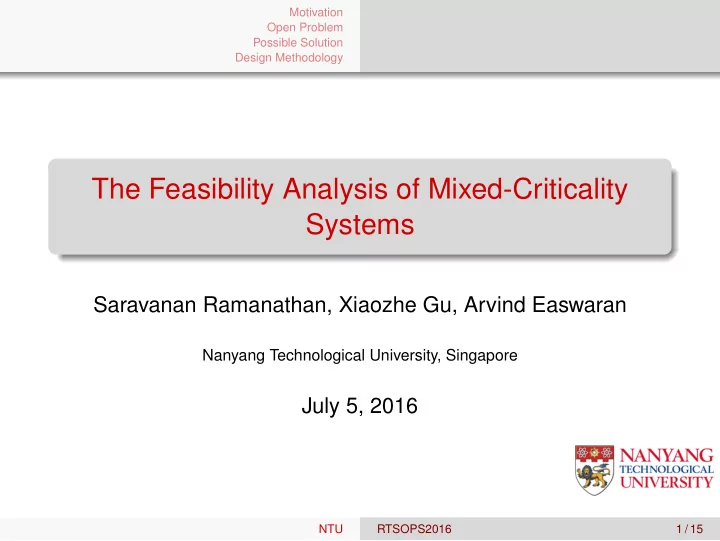

Motivation Open Problem Possible Solution Design Methodology The Feasibility Analysis of Mixed-Criticality Systems Saravanan Ramanathan, Xiaozhe Gu, Arvind Easwaran Nanyang Technological University, Singapore July 5, 2016 NTU RTSOPS2016 1 / 15
Motivation Open Problem Possible Solution Design Methodology Outline Motivation 1 Open Problem 2 Possible Solution 3 Design Methodology 4 NTU RTSOPS2016 2 / 15
Motivation Open Problem Possible Solution Design Methodology Outline Motivation 1 Open Problem 2 Possible Solution 3 Design Methodology 4 NTU RTSOPS2016 3 / 15
Motivation Open Problem Possible Solution Design Methodology Motivation NTU RTSOPS2016 4 / 15
Motivation Open Problem Possible Solution Design Methodology Outline Motivation 1 Open Problem 2 Possible Solution 3 Design Methodology 4 NTU RTSOPS2016 5 / 15
Motivation Open Problem Possible Solution Design Methodology The open problem What is a tight feasibility bound for Mixed-Criticality (MC) task systems? NTU RTSOPS2016 6 / 15
Motivation Open Problem Possible Solution Design Methodology Outline Motivation 1 Open Problem 2 Possible Solution 3 Design Methodology 4 NTU RTSOPS2016 7 / 15
Motivation Open Problem Possible Solution Design Methodology Possible Solution Mixed-Criticality System: Single-core / Multi-core scheduling Dual-criticality / Multi-Criticality system Periodic / Sporadic task model Implicit / Constrained deadline NTU RTSOPS2016 8 / 15
Motivation Open Problem Possible Solution Design Methodology Possible Solution Mixed-Criticality System: Single-core / Multi-core scheduling Dual-criticality / Multi-Criticality system Periodic / Sporadic task model Implicit / Constrained deadline NTU RTSOPS2016 8 / 15
Motivation Open Problem Possible Solution Design Methodology Mixed-Criticality Task Model Task Model: Implicit-deadline dual-criticality (namely LO and HI) periodic task system is being considered. τ i = ( T i , χ i , C L i , C H i , D i ) T i ∈ R + is the period, χ i ∈ { LO , HI } is the criticality level, C L i and C H are the LO- and HI-criticality Worst-Case i Execution Time (WCET) values respectively; we assume C L i ≤ C H and, i D i = T i is the relative deadline. NTU RTSOPS2016 9 / 15
Motivation Open Problem Possible Solution Design Methodology MC Feasibility Analysis U H H System-level Necessary Condition 1 utilizations are defined as def U L τ i ∈ τ L u L = � i , L 3 / 4 Sufficient Condition U L def τ i ∈ τ H u L = � i and H def U H τ i ∈ τ H u H = � Feasible region H i where, u L i = C L i / T i and u H i = C H i / T i 3 / 4 0 1 U L L + U L H NTU RTSOPS2016 10 / 15
Motivation Open Problem Possible Solution Design Methodology Outline Motivation 1 Open Problem 2 Possible Solution 3 Design Methodology 4 NTU RTSOPS2016 11 / 15
Motivation Open Problem Possible Solution Design Methodology Design Methodology Challenge: Determining the worst-case mode switch pattern NTU RTSOPS2016 12 / 15
Motivation Open Problem Possible Solution Design Methodology Design Methodology Challenge: Determining the worst-case mode switch pattern Solution: Fluid model Execution rate ( θ i ) determines the mode switch instant ( C L i /θ L i ) Non-MC systems: Most fluid algorithms are optimal NTU RTSOPS2016 12 / 15
Motivation Open Problem Possible Solution Design Methodology Design Methodology Design of optimal scheduling algorithm involves In LO mode: Schedule LO-criticality tasks as late as 1 possible In LO mode: Schedule HI-criticality tasks with their virtual 2 deadline ( C L i /θ L i ) In HI mode: Optimal scheduling of HI-criticality tasks 3 inclusive of carry-over demand of HI-criticality tasks. NTU RTSOPS2016 13 / 15
Motivation Open Problem Possible Solution Design Methodology Design Methodology HI-mode schedulability: In the absence of LO-tasks, fluid scheduling can optimally schedule HI-tasks in HI-mode. NTU RTSOPS2016 14 / 15
Motivation Open Problem Possible Solution Design Methodology Design Methodology HI-mode schedulability: In the absence of LO-tasks, fluid scheduling can optimally schedule HI-tasks in HI-mode. LO-mode schedulability: Use DP-Fair to schedule HI-tasks in LO mode 1 Virtual deadline ( C L i /θ L i ) and actual deadline ( T i ) Schedule LO-tasks as late as possible 2 NTU RTSOPS2016 14 / 15
Motivation Open Problem Possible Solution Design Methodology Thank you..! Questions..? NTU RTSOPS2016 15 / 15
Recommend
More recommend